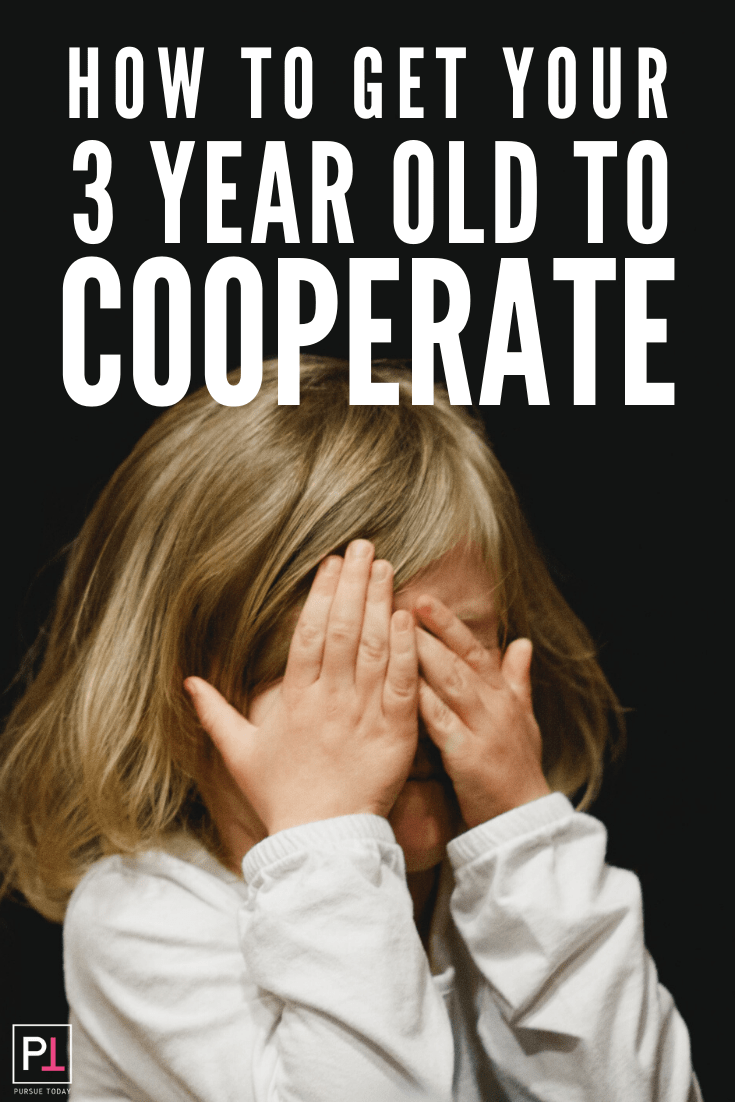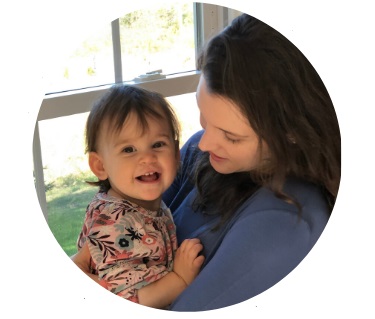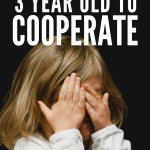
If you need some new strategies on dealing with defiant uncooperative toddler behavior, then this post is for you. I know just how tough it can be to find ways to get your toddler to cooperate. So to avoid the power struggle, here are some unique strategies and language that I use to prevent temper tantrums and meltdowns. My favorite part of these is that they also benefit your toddler by helping them build important problem solving skills.
Note: I use the word toddler but these tips apply to both toddlers and preschoolers.
Ask what part can I do?
When your toddler is refusing to let you do a task and wants to do it “all by themselves”, this is a great way to teach teamwork and compromise.
To do this, ask them what part you can do. For instance, “what teeth can I brush?” My toddler will point to a tooth and tell me I can brush that one. I then say okay and brush that section. I then ask now what teeth can I brush? With the car seat, I do the same thing and ask what part I can do. I also might give a suggestion like, can you do the top buckle and I do the bottom one?
I have been using this strategy since my toddler was 2. Now that my toddler is almost 4, I now also use this as a strategy to build social skills. This can help her problem solve with other kids and be used as a way to enter play. For instance, if she sees some kids playing a game like pretend house, I tell her to go ask what she part she can do?
A fun way to “Let them be right”
This is for the older toddler but once they understand this game, it will be the best way to diffuse a situation. Laughing helps release emotion. It lightens the mood.
So, when your toddler won’t do something like get their pajamas on or wash their hair, play this game.
Let’s say they won’t put their pajamas on, take their pajamas and say so you wear them like this (put pajama pants on your head). They will love to tell you no. And then repeat it, “oh you wear them like this!” (pajama pants on your arm). After a few times, ask them to show you how to do it. Sometimes, they might even take it themselves and show you how to do it.
I don’t know why this works so well but I think that because all day they have adults telling them how to do things that it is really nice for them to reverse the roles.
The game that will end the food battles
I have written a whole post on picky toddler eaters since it was such a battle in our house. The first things I had to learn was that by always asking if she liked it, I was saying the only option was to like it. And as I have now learned, she probably didn’t like it. On average, it takes trying a new food at least 20 times before you will like it. So you must find ways to expose your child to different foods again and again.
This game was life-changing for us. At dinnertime, I would pick a food to try such as a tomato. I would give everyone a bite size portion. I then ask who is going to go first. To increase interest, have the other adult be super excited and want to go first. They then try the food and make silly faces. They then describe what it tastes like such as sour, sweet, squishy etc. Also, we make up funny things like it tastes like red bananas or red socks. When someone gives a funny answer, you can say things like “what no, it can’t taste like socks that’s so silly.” The goal is to make it as fun and silly as possible.
You play until everyone at the table has tried the food. By making it one bite, it allows them to start getting used to the different tastes and textures. My toddler now asks what food are we trying. I have been able to expand her diet so much with this simple game.
Use my turn/your turn strategy
So one way we worked on allowing cooperation is to play my turn/your turn.
Start by doing this with toys. It is actually a great way to teach sharing. Play with a toy and say my turn and then hand it to them and say your turn. Continue doing this during play so that they understand the concept. Even a very little toddler can start to understand this idea
Then when you get to something that is causing a fight such as your toddler doesn’t want to brush their teeth or they want to brush their teeth all by themselves, then say my turn/your turn. You can hand the tooth brush to your toddler and say your turn. And then say my turn. We trade back and forth usually every 15 seconds, but it works.
I like this strategy because they practice a valuable skill, sharing.
Avoid open ended questions
Giving kids choices such as do you want to wear turtles or elephant pajamas to bed is a must. Not only does it avoid the power struggle of no/yes all together but also it avoids open ended questions.
The open-ended questions are always going to be trouble because kids can not recall words as quickly or as well as we assume. It also allows you to have some control over the outcome.
For instance, the difference in asking what do you want for snack vs would you like a banana or apple with peanut butter for a snack? In the first question, the answer will most likely be their favorite food like cheese. Their answer will also be one of the most common things they eat because they will recall the word for that food the quickest.
To really see and understand how hard it is to recall words, play a game such as name foods. Keep having them name as many as they can and you will see they start to struggle after a just a few.
Take some time to intentionally “be preventative”
I know we all know we can do this but sometimes I just forget. For instance, having my kids get their pajamas on right after dinner before they are super tired saves me so much fighting. And yet, it took me forever to start doing that.
So take some time one night and review the day to think what changes could I make that would prevent some of our biggest meltdowns. While this won’t fix everything, I find that if I can remove a few big meltdowns a day, I am a much more saner person by the end of the day.
In addition to pajamas, a big fight in the morning is getting my kids to put on shoes and jackets. So instead I put all of that in the car. Once we arrive at school and daycare, they put on shoes without a fight. While it is annoying to carry them to the car in the morning, it is worth it to avoid the meltdown.
Avoid the power struggle by involving them in the solution
I feel like as a parent of a toddler, you are constantly following them around telling them what they can and can not do (and for good reason!) But this can be very annoying for both of you.
What really helped me was to learn to state an observation without judgement and then pose a question. For instance, imagine your toddler is fighting over a toy with their sibling. My old go-to was to try to fix it by telling them the right thing to do such as “you have to share” or “give the toy back because she had it first”. My toddler would follow up with the infamous NO!
Now, I make an observation such as “I see you both want the ball, that is tricky. What could we do?” This makes the child participate in the solution. You are starting to build foundational conflict resolution skills that they will carry on throughout life.
The older toddler will offer solutions especially as you practice this skill. If I get no answers, I will add some suggestions or choices that could be used such as “we could find another ball or we could offer a trade such as a different toy.”
When I started doing this, it was really hard. It took a lot more patience and work on my part. It was so much easier to tell them what to do to resolve conflicts. However, after I started doing this, I was amazed at how much it helped my toddler.
She now uses the solutions on a regular basis that we come up with and I don’t even have to intervene at all. I also really like the method because they are not mad that the solution was unfair. Since they came up with it, you have happy campers after.
Talk and talk and talk about emotions.
A big part of toddlerhood is learning about and how to deal with emotions.
There are four emotions (sad, scared, mad and glad), everything else can be categorized in one of these. Being able to understand which emotion they are feeling, express it with words and then decide how to manage their emotion is a skill that most adults still struggle with. And that is because most of us weren’t taught this when we were little.
I have had to do a lot of growing and learning how to handle my own emotions better. A fascinating book I read was Emotionally Unavailable, which talks about how adults do all kinds of things to avoid emotions.
My absolute favorite strategies for toddlers and emotions include:
Name it to tame it, a strategy in the Brain Rules for Baby book, where you state the emotion, so they have a way to express it. At this age, they do not usually know they are feeling sad, mad etc.
Learning how to cool off by reading Jared’s Cool-Out Space by Jane Nelson (creator of positive discipline).
Blowing out birthday candles to calm down. I use this when I can’t get my toddler to take deep breaths. I hold up 3 fingers and ask her to blow out her birthday candles. (Do 3 if they are 3, 2 if they are 2 etc.) Every big breath they do blows out one candle so my three-year-old does 3 big breaths.
Squeezing imaginary play dough in your hands to calm down especially when they don’t want to blow out birthday candles.
Reading books about emotions. Ask your librarian to suggest some good books that talk about emotions that would be age appropriate. We have found some really great ones this way like the WorryWoo Monsters by Andi Green and Glad Monster Sad Monster by Ed Emberely and Anne Miranda.
Heard your feelings cards are a great tool for learning and talking about emotions. Each card depicts a different social situation. There are questions on the back and you two can talk about the situation, what everyone is feeling and ways to resolve those feelings. For instance, Cat looks lonely, she could ask the other kids playing if she could play too. Honestly, at first I thought these would be boring and not helpful but I was shocked at how much my toddler loves them. It just shows that this is what they are interested in learning at this age.
Set limits but let them know you are on their side
No matter how little you are, there is just something human about wanting someone else to acknowledge that they understand you. I have found that if I do this before setting a limit then the result is always so much better. So what you do to do this is state in words what they want, let them know you are on their side and then state the problem. You can also end with choices or a solution.
Here are examples
You want to keep playing at the playground. I wish I could let you keep playing, it looks like so much fun. The problem is that it is lunchtime so we have to go and eat our lunch.
If they give you some solution, then applaud them. Problem solving is a fantastic skill for life.
I then end with something like this to help us get going. You will see that they all give the child some control of the situation.
Could you help me think of some good lunch ideas while we walk to the car?
Could you help me set a timer and when it goes off we can walk to the car together?
Could you carry the keys and help me unlock the car?
We could come back, could you help remind me later that we want to come back? Could you be my big helper and do that?
I always get a lot more cooperation from my kids when I use this structure.
Separate action from child
Speaking of emotions, this is the age where you need to help your child know that emotions are okay but certain ways of expressing them are not okay. And that it is the action not the child that is bad.
For instance, if my child is mad and pushes, then I would say it is okay to be upset but I can not let you push. Pushing is not okay. What could we do instead? (pause to let her come up with an answer) Let’s take a deep breath to reset and try again with words.
I then give my child the words to use and have her repeat them so that she gets to practice handling the situation in the correct way.
They learn from you
I know you all know this. But what I missed was that I could be more intentional on this. Seriously use this to your advantage, think about how you want them to act and then do it yourself.
It finally occurred to me that I don’t demonstrate how I want my child to handle emotions. I have never expressed my feelings. I have never said, I am mad that we ran out of coffee and then tell her I need to take some deep breaths. And then come up with a solution.
I also started to model how she could talk to other kids and how she could play with them. I would always say hi, my name is ….. do you want to play with us? After a few weeks of modeling this, I was shocked at how my toddler started going up to other kids and telling them what her name was and asking if they wanted to play.
They can talk a lot but don’t let that fool you.
They might know a lot of words and be able to repeat a lot of phrases, but it is still hard to recall the correct ones every time.
A lot of times, we tell kids what not to do and decoding that is actually a complex process. For instance, maybe you say “don’t eat the marker.” Your toddler might understand those words, but they also have to understand from that phrase what to do with the marker. So instead say, “draw with the marker” and show them.
Another helpful thing to do is to model the language you want them to use. If they are demanding a toy, then you might say ask nicely. Instead just say what you want them to say, “may I have the toy please?” It even works when they do not have many words yet, just always say what you want them to say such as I would like more please, or Can I have a drink please? The more they practice repeating after you, the more language they learn.
If they are also hungry, tired, angry or lonely, then it is even harder for your toddler to find words. My favorite phrase is HALT, which stands for hungry, angry, lonely, and tired. It is a reminder to halt before engaging and see if any of these apply.
Time to ditch the habit of talking about them in front of them
It was okay when they were babies and we moms would meet up to complain about sleep or breastfeeding. You still need to be able to vent but now, your child will take this to heart. They understand you.
Additionally, kids have this tendency to do what they hear. You might say, “Alex is always eating playdough.” There is a very high chance that if playdough is out and Alex heard, then he is going to go over there and eat playdough.
Only praise, never compare
Whether it’s a sibling or a friend, a great way to increase resistance in your toddler (or any age kid) is to compare them. Let’s say you are talking to your child and said “wow look at how Sophia puts her jacket on, let’s get your jacket on like Sophia.” Your toddler only hears that they aren’t as wonderful in your eyes as Sophia.
Instead, talk directly to Sophia and say, “Sophia, wow great job on getting your jacket on.” You don’t need to point out her good behavior to your child. Just give praise to the child who deserves it. Your child has now registered in their brain that putting on a jacket gets praise from you whereas in the first situation, the child viewed the interaction as negative on them.
Pursue your toddler Today
Remember this is just a phase. Your child loves you so much! This is a difficult age for them as they try to manage their emotions, do everything by themselves, and also continue learning how to use their words. And it is a difficult phase of parenting for you because this stuff is hard to teach. Most adults can’t manage their own emotions and they have had years upon years of practice.
I promise one day you will look back fondly on these years. And you can teach them a lot in these little years if you have the tools to do so. I hope I have given you some tools so that you can be the parent you want to be.
If you found this post on managing preschool meltdowns helpful, please share it on Pinterest or Facebook


I am a wife, teacher, and mother to two awesome girls. I write about what I am passionate about, which includes being a mom, house projects, beauty and skincare. I love to share my experiences, failures, and successes with my readers. Let this space be a resource for you to pursue your very best day.







